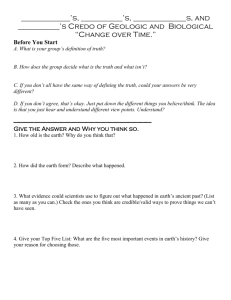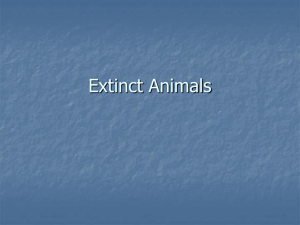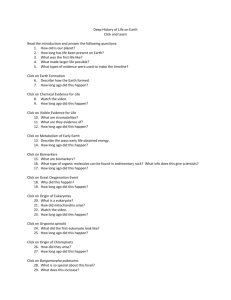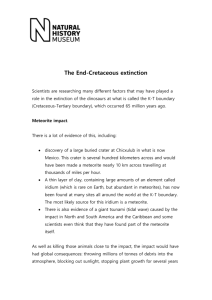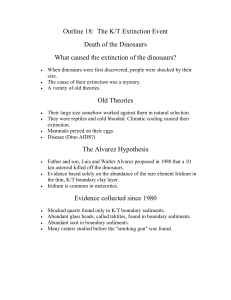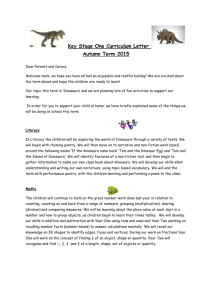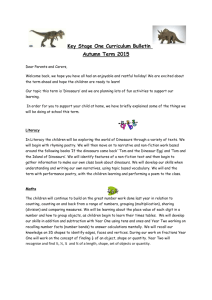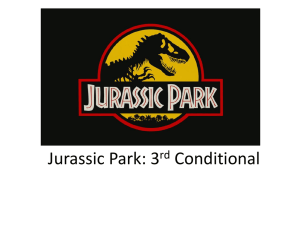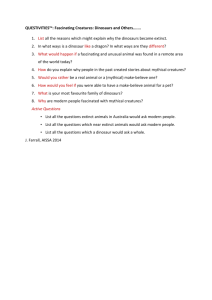The Mesozoic Era
advertisement
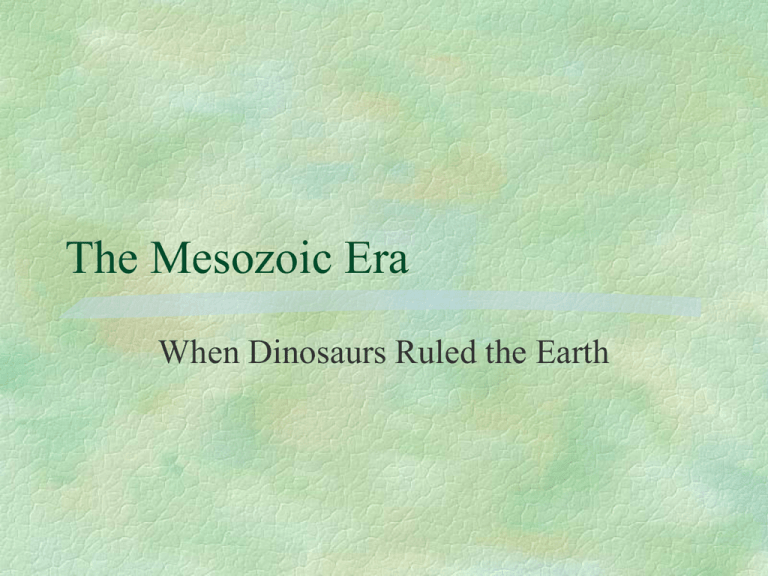
The Mesozoic Era When Dinosaurs Ruled the Earth The Mesozoic Era Began approximately 245 million years ago after a major mass extinction. Is subdivided into 3 periods: Triassic Jurassic Cretaceous Ends about 66 million years ago with a major mass extinction Mesozoic Reptiles Turtles Crocodiles/Alligators Lizards Ichthyosaurs (large marine reptiles) Pterosaurs (large flying reptiles) Dinosaurs (land dinosaurs) Dinosaurs Myths All dinosaurs are the same Everything that is big and extinct is a dinosaur All dinosaurs lived at the same time All ‘dinosaurs’ are extinct… ...you’ll see! The Triassic Period 245 - 206 million years ago Immediately after the Permian Mass Extinction Lots of new area is open for animals to live Three general types of animals: holdovers from before the extinction new groups that lasted only a short time new groups that lasted a long time The Triassic World Triassic Plant Life Mosses Scale Trees (like palm trees) Ginkos (my favorite) Two Groups of Dinosaurs Ornithischian Hips were similar to modern bird hips Carnivorous short-necked Herbivorous, long-necked Saurischian Hips were similar to reptile hips Herbivorous with grinding-teeth Herbivorous without grinding-teeth Earliest Dinosaurs (Triassic) Pisanosaurus Length:3 feet Height:1 foot Weight:15 pounds Eoraptor: Length:3 feet Height:1 feet Weight:20 pounds Lesothsaurus: Length:3 feet Height:1 foot Weight:15 pounds The Jurassic Period 206 - 144 Million Years Ago Giant plant-eating dinosaurs Vicious carnivore dinosaurs Oceans full of fish, squid, sharks, etc. Ichthyosaurs and Plesiosaurs Pterosaurs Birds The Jurassic World Jurassic Plant Eating Dinosaurs Many different forms Many had ‘armor’ to protect themselves Triceratops Triceratops Ankylosaurus Many very large (larger than a Rhino/Hippo) Some were extremely large (as long as a city block): Diplodocus Ankyloasaurus Diplodocus Jurassic Carnivorous Dinosaurs Many different forms Some were very large: Tyrannosaurus Rex Allasaurus Some were smaller: Raptors, and many more All had sharp teeth, claws, and speed Jurassic Marine Dinosaurs Most with similar shapes as a dolphins or sharks Ate fish and other marine animals Some were VERY large All could swim VERY fast Ichthyosaurus Jurassic Pterosaurs Pterodactyls and Pterosaurs Most had trouble ‘walking’ Were very good flyers Had hollow bones Small (~ 1 foot) and very large (~ 16 feet) More Pterodactyls Jurassic Birds(?) - Archaeopteryx Not a Pterosaur Jaws and bone structure like dinosaurs Bones are hollow, like birds Feathers Was this an evolutionary link between dinosaurs and birds? The Cretaceous Period 144 - 66 million years ago The last period when Dinosaurs lived Ends with a mass extinction around 66 million years ago First flowering plants! The Cretaceous World Cretaceous Plants First plants with flowers Their appearance was very rapid They appeared at the same time as the number of insects increased… Could insects have helped the flowering plants evolve? The Cretaceous Mass Extinction Approximately 60% of all species went extinct. Affected many land animals/plants Affected fewer marine animals What organisms went extinct? All dinosaurs All pterosaurs All ichthyosaurs Many terrestrial plants Many marine animals What organisms survived? MAMMALS (!) Birds Many plants (ferns were the most successful plant for a while) Trees with flowers Small lizards/crocodiles/alligators/turtles Fish, squids, sharks, etc. What caused the extinction? Meteorite impact theory 66 million years ago, a ~10 km wide meteorite struck the Earth near what is now Mexico. Meteorite Impact This is an EXAGGERATED view of a meteorite impact How could a meteorite impact cause a mass extinction? The impact caused shock waves, tidal waves, and sent a tremendous amount of dust into the atmosphere As the dust re-entered the Earth’s atmosphere, it would have instantly heated the atmosphere causing tremendous forest fires The dust could have caused the Earth’s climate to cool in the long-run by blocking sunlight Plants, animals, etc went extinct due to the climate changes and competition between organisms Meteorite Impact Evidence #1 Unique Quartz Crystals Very commonly formed under high pressure/temperature This quarts was only found in meteorite craters and nuclear testing sites Meteorite Impact Evidence #2 Iridium An element that is very rare in Earth rocks and very common in meteorites The layer of rocks above the last dinosaur bones contains ~160 times ‘normal’ levels of iridium Problems with the Meteorite Impact Hypothesis Why were some animals affected, while others were not? Why did birds survive, and dinosaurs (a very close relative) not? Why did small reptiles survive when small dinosaurs didn’t? Why did mammals survive? Out-dated Hypotheses Hay Fever - caused by flowering plants Dinosaurs were so big, that they crushed themselves Mammals out-competed the dinosaurs Mammals ate all the dinosaur eggs Cosmic rays killed the dinosaurs

